 by Eric R. Pianka and Wendy L. Hodges Erroneously called "horny toads," horned lizards are bizarre, spiny, ant-eating lizards unlike any other lizards in North America. Fourteen species are currently recognized, 8 of which are found within the continental USA (one reaches southern Canada), and 6 other little-known species are restricted to Mexico (one reaches Guatemala). Most horned lizard species are well represented in the fossil record by the Pleistocene (1 million years ago, mya), P. cornutum is found in the upper Pliocene (3 mya), and P. douglasi is known from the mid Miocene (15 mya). Three species went extinct in the late Pliocene-early Pleistocene, long before there were any humans. The genus is thought to have split from an ancestor shared with the sand lizards (Uma, Callisaurus, Cophosaurus, and Holbrookia) during the late Oligocene-early Miocene (23- 30 mya). 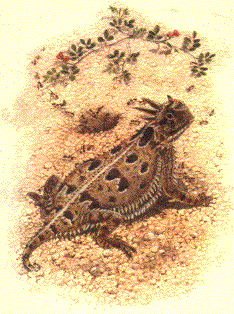
Humans and horned lizards have shared each other's company for thousands of years. This relationship is recorded from Anasazi, Hohokam, Mogollon, and Mimbres cultures through their use of horned lizard images on pottery, petroglyphs, effigy bowls, figures, and shells. Hopi, Navajo, Papago, Pima, Tarahumara and Zuni cultures portray horned lizards in their ceremonies and stories as symbols of strength. Piman people believe horned lizards can cure them of a staying sickness by appealing to the lizard's strength and showing their respect to the animal. They formulate a cure by singing at a patient's side songs describing the lizards and their behaviors. A horned lizard fetish may be placed on an afflicted person's body during the songs. Native Mexican people also respect horned lizards attributing the words, "Don't tread on me! I am the color of the earth and I hold the world; therefore walk carefully, that you do not tread on me." A Mexican common name for horned lizards is "torito de la Virgen" or the Virgin's little bull. This name apparently was given to the lizards both because of their horns and because horned lizards are sacred to many people due to their blood squirting behaviors, otherwise considered weeping tears of blood. These interesting lizards were first introduced to European audiences in 1651 by the Spaniard Francisco Hernandez. Hernandez was fortunate to observe a living individual which squirted blood from its eyes -- he noted this behavior in his report on the first scientific expedition to Mexico by Spain. Over a century later in 1767, a Mexican cleric of Spanish descent, Clavigero, also showed his wonder of horned lizards in his illustrated volumes of Mexican history. Still later, in 1828 Wiegmann coined the official scientific generic name Phrynosoma, which is Greek for toad-bodied (phrynos means "toad", soma means "body"). Species descriptions Horned lizard species are distinct and easily recognized from each other. Arrangement of occipital and temporal horns on the head are enough to distinguish species, but other features such as number of rows of lateral, abdominal fringe scales and dorsal scale patterns are helpful, too. Color or color patterns generally are not good distinguishing features because these lizards are extremely variable and tend to match the color of the sand or rocks in their local environment. However, color can be used in certain circumstances as stated in species' descriptions below. The geographic ranges described below are based on historic records and do not reflect species' current distributions. Ranges of most species have been severely reduced. 
Phrynosoma asio, Long Spined Horned Lizard Diagnostic Characters:
Geographic Distribution: This is the largest species attaining snout-to-vent length (SVL) of 115 mm and total length of 202 mm (8 inches). It occurs in southern Mexico from Colima through coastal Michoacan, Guerrero, Oaxaca, to Chiapas, and in the Balsas Basin. It is recorded from Guatemala. Phrynosoma boucardi Diagnostic Characters:
While this species has been recognized as distinct, it has also been relegated to the subspecies P. orbiculare boucardi because the morphological characters that diagnose it are found on intermediate forms in the P. orbiculare group, although not all characters are found together. P. orbiculare is a wide ranging species and occurs very near specimens called P. boucardi More information is needed to sort out the taxonomy of P. boucardi. Phrynosoma braconnieri Diagnostic Characters:
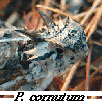
Phrynosoma cornutum: Texas horned lizard Diagnostic Characters:
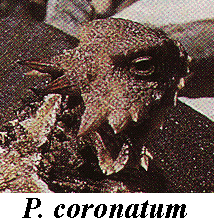
Phrynosoma coronatum: Coast horned lizard Diagnostic Characters:
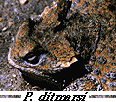
Phrynosoma ditmarsi: Rock horned lizard Diagnostic Features:
This species was "lost" to science for about 65 years. Its unique habitat preferences and limited distribution, combined with a very imprecise holotype locality record made it difficult to locate. An extraordinary effort by Vincent Roth based on a cross-correlational analysis of gut contents from only three specimens led to its rediscovery. 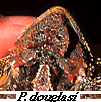
Phrynosoma douglasi: Pygmy Short-Horned Lizard Diagnostic Characters:
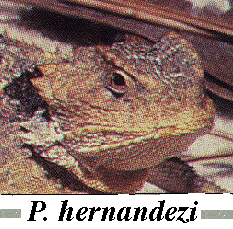
Phrynosoma hernandezi: Short-horned lizard Diagnostic Characters:
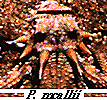
Phrynosoma mcallii: Flat-tailed horned lizard Diagnostic Characters:
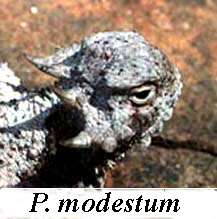
Phrynosoma modestum: Round-tailed horned lizard Diagnostic Characters:
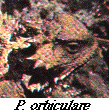
Phrynosoma orbiculare: Chihuahua desert horned lizard Diagnostic Characters:
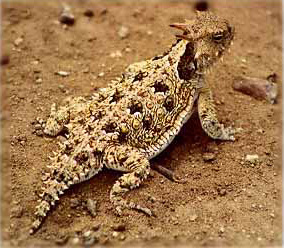 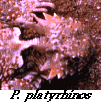
Phrynosoma platyrhinos: Desert horned lizard Diagnostic Characters:
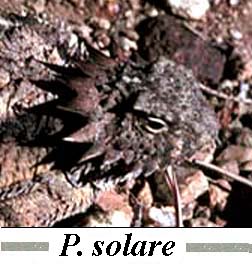
Phrynosoma solare: Regal horned lizard Diagnostic Characters:
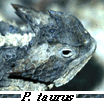
Phrynosoma taurus: Diagnostic Characters:
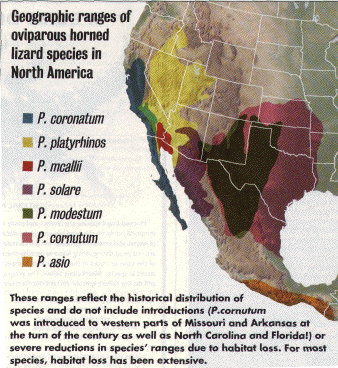 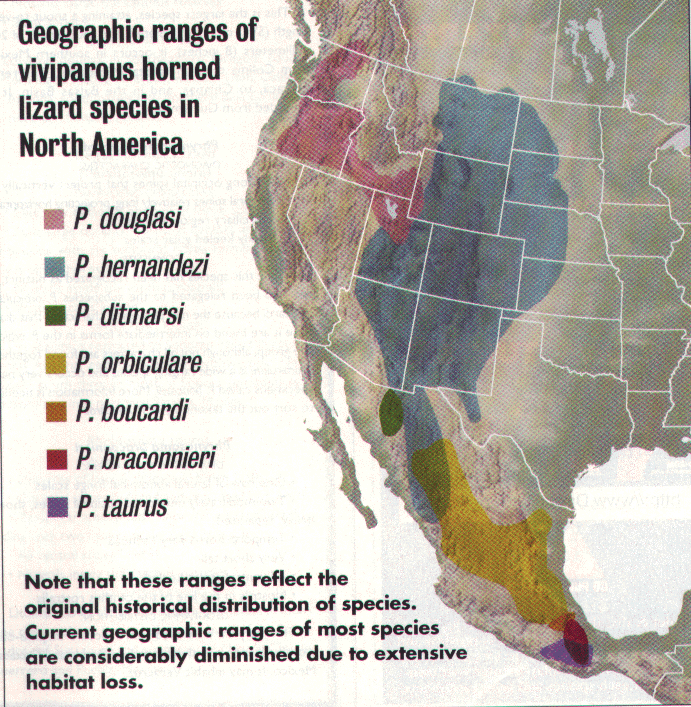 Phylogeny and Natural History Phylogeny allows us to trace evolutionary history and relationships of organisms. Much like humans draw their genealogies, or family trees, to discover where their blue eyes or baldness came from, or perhaps whether they are genetically predisposed for cancer -- systematists construct such trees to show how different species have evolved. Ecologists use phylogenetic relationships to learn how characteristics of species evolved, or how different species acquired traits and evolved to occupy their current niche. Principles of parsimony are used to identify the simplest explanations for how a trait evolved. There are two major lineages of horned lizards, one of which lay eggs (oviparous) while members of the other group give birth to living young (viviparous). Although the ancestral state is oviparity, one lineage of horned lizards, all high altitude species, has evolved live bearing (braconnieri, boucardi, ditmarsi, douglasi, hernandezi, orbiculare, and probably taurus). Viviparity appears to have arisen only once in the genus, rather than independently 5 times. Interestingly, all species are montane which provides support for the idea that drier and colder mountain climates demand that montane lizards retain their progeny internally until birth rather than laying eggs. Horned lizards are a rather fecund group, and lay or give birth to many offspring compared to other lizards. The median clutch size for P. cornutum is 25 (one specimen laid 40 eggs!), P. asio lays 17 on average, and P. hernandezi bears up to 16 live lizards. Reproductive effort measures the resources given to producing offspring and is often measured by comparing the weight or volume of the offspring to female volume or body weight (relative clutch mass, or RCM). RCM among horned lizards ranges from 13% to 35%, (offspring constitute from 13-35% of a female's weight). Females can have a few large versus many small progeny. Some species also reproduce twice in a season. This large investment in offspring throughout the active season weighs down females and makes them vulnerable to predators. Because babies are tiny and easy prey for a multitude of predators, horned lizards would go extinct without such high fecundities. An interesting more recent analysis of horn lengths among horned lizards is shown in the above figure from Leache and Maguire (2006). Preferred phylogeny for Phrynosoma based on combined mtDNA and nuclear data. The most parsimonious reconstruction of antipredator blood-squirting (ABS) is mapped on the phylogeny (black bars). Blood squirting behavior was ancestral and has been lost 4 times. Silhouettes of Phrynosoma heads are shown to illustrate the variation in cranial horn anatomy, color coded to correspond to relative horn length (ancestral state reconstructions mapped on each node). The asterisk adjacent to P. taurus indicates that the effective length of the squamosal horns of this unusual species are longer than portrayed by the measuring technique employed. Four Phrynosoma clades, TAPAJA, ANOTA, DOLIOSAURUS, and BREVICAUDA are marked (from Leache and Maguire 2006). Horned lizards have evolved a variety of mechanisms to avoid their predators which include loggerhead shrikes, hawks, roadrunners, a variety of snakes, coyotes and foxes. Their first line of defense is to remain cryptically hidden from a predator's sight. This is accomplished by three things, matching the background color of the substrate, possessing various spines and fringes of scales which decrease their shadows, and they remain motionless when approached. Secondly, their formidable body armor of spines and horns pose a significant threat to many predators as witnessed by snakes and birds found dead with lizards' horns projecting through predators' throats. Horned lizards will capitalize on their armor by inflating their bodies with air until they look like spiny balloons. At least four species of horned lizards (but not all species), coronatum, cornutum, orbiculare and solare, squirt blood from their eyes when attacked, especially by canine predators such as foxes and coyotes. The canine will drop a horned lizard after being squirted and attempt to wipe or shake the blood out of its mouth, clearly suggesting the fluid has a foul taste. Older horned lizard phylogenies suggest that blood squirting behavior either evolved independently 4 times or it evolved only once and was then lost in subsequent lineages. Leache and Maguire's more recent tree suggests blood squirting behavior was ancestral and has been lost 4 times. This behavior is currently being investigated by Dr. Wade C. Sherbrooke, Director of the Portal Research Station of the American Museum of Natural History. |